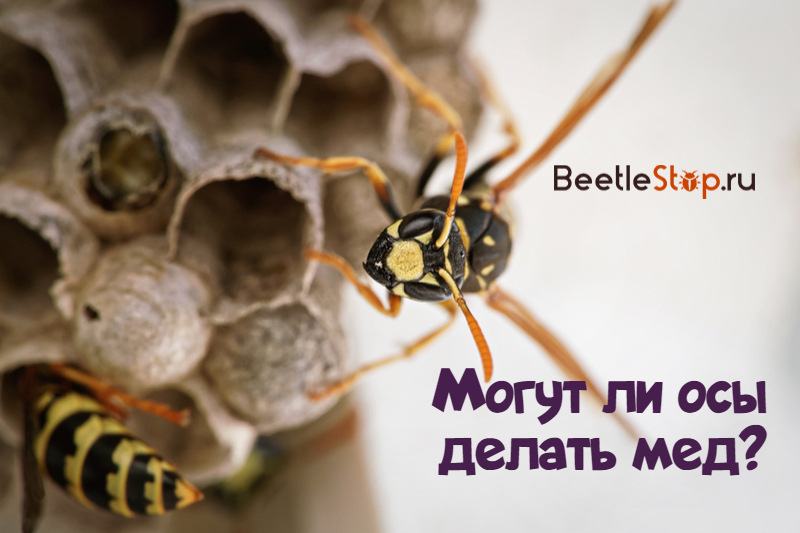Do wasps make honey? Features of insect life
Wasps and bees are the closest relatives, because they belong to the suborder of stalk-bellied insects. Both species have black and yellow color and sting. They are similar in lifestyle: they feed on nectar and juice of sweet fruits, playing an important role in pollination of plants. Naturally, some people have a question: do wasps make honey like bees?

Can a wasp make honey?
Wasps include at least 11 families of stalk-bellied insects. They are settled throughout the globe. The answer to the question, whether wasps give honey, will only be partly in the affirmative. Indeed, some of the species produce a product remotely similar to it, which differs from the bee habitual to everyone.
Wasps capable of producing honey live in hot countries. Therefore, hives of individuals living on the territory of Russia, Ukraine, Belarus and other neighboring countries are not of interest for the flight.
Wasps collect very little nectar. Its quantity is sufficient only for feeding individuals in the hives, and there is no need to talk about vast stocks of honey. Moreover, it is not honey as such. The structural features of the pharyngeal glands of the wasp, unlike bees, do not provide for the production of special enzymes, due to which the conversion of nectar into this most valuable product through a chemical process.
Honey wasp
Science knows about two types of wasps capable of producing such a quantity of honey that is of economic interest:
- Polybia Occidentalis from the Vespidae family. It lives in Mexico, some countries of Central and South America. It produces more honey than other types of wasps, creating reserves in the hives. True, it looks more like nectar. It is necessary for the nutrition of adult individuals and larvae of Polybia Occidentalis in the development process. It is known that local tribes of the Indians engaged in tropical activities in tropical forests to feast on this honey. This is a rather complicated and dangerous task, because honey wasps aggressively protect their hives from invasion.
- Brachygastra lecheguana, or Mexican honey wasp (in English literature - Mexican Honey Wasp). The body length of adults is 1 cm. They build paper nests in the crowns of trees, while the diameter of the hives reaches 0.5 m. One dwelling is enough for 10 thousand wasps. Despite the name, they live not only in Mexico, but also in South American countries, in particular in Brazil. Local people living in rural areas sometimes use their honey for food. Differ in non-standard honeycombs.
Paper nests are made from paper produced by the insects themselves. For this, wasps chew wood, soaking it with their saliva with sticky properties.
All honey wasps are the oldest creatures from an evolutionary point of view. They are at a lower developmental level than bees. The collection of their honey by local Native American tribes has been known since ancient times as a primitive type of gathering and a precursor to pilgrimage in the modern sense. But even today in the jungles of Central and South America you can find people who know what hornet honey tastes like.
Is it possible to eat wasp honey?
Wasp honey is a mixture of pollen and nectar with a very thick consistency with a pronounced sweet taste and a pleasant floral smell. These insects, like bees, pollinate flowering plants, choosing those that are located not far from the hive. Therefore, the taste of honey from each nest can be considered individual.
Wasp honey is quite nutritious, because it contains various plant components. But in its value, it undoubtedly loses to the bee, because in its composition there are no special enzymes. Without these substances, honey quickly loses its positive characteristics: ductility disappears and the crystallization process begins. But, despite this, it is suitable for eating.
A person accustomed to bee honey will immediately feel the difference with wasp. The product is more like nectar collected from surrounding flowering plants.
What else are wasps for?
Having found out who makes honey - bees or wasps, one should not consider the latter as useless creatures. Like most representatives of the fauna, they participate in important natural processes, helping to maintain a natural balance and harmony in the world.
The benefits of a wasp are:
- Pest control. Offspring of wasps feed on the larvae of various pests, including wood and agricultural. For example, an earthen wasp is the worst enemy of a bear, causing irreparable damage to landings. Knowledgeable gardeners specifically plant flowering plants and trees in areas around the perimeter to attract these black and yellow insects.
- Amorphous wasps in large numbers exterminate caterpillars.
- Other species (nosy, paper, etc.) destroy all kinds of beetles, including grinders, flies, cicadas.
- The main function of wasps in wildlife is the pollination of plants from which insects collect sweet nectar.
People do not like wasps because of painful bites that cause swelling and redness of the skin and tissues. Their venom is comparable to toxicity with bee venom, and 20 bites in a short period of time pose a health hazard. But these insects rarely attack humans on their own initiative. This usually happens if it poses a threat to the hive, waves its arms or touches a wasp. By following simple safety precautions, you can protect yourself from unpleasant bites.


 (votes: 25, average rating: 4,64 out of 5)
(votes: 25, average rating: 4,64 out of 5)